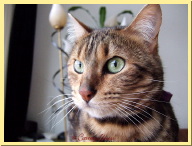 |
|
Hybrids with a bengal parent
|
|
I obtained this info from:
Messy Beast Archive Bengal FAQ Egyptian Mau FAQ February 1996 Newsletter Wikipedia Savannahcatbreed.com You can click on the pictures I used, to go to the site they belong to. If you find your photo here and you object to my way of referring to your site or showing your photo, please email me and I will remove it at once. |
|
Glossary
With so many different registries with different views, the exact status of some breeds is hard to define. The following terms are used:
|
|
Status
|
Breed Name
|
Description
|
| Uncertain |
 |
Blending 2 exotic feline bloodlines (African Serval and the Asian Leopard Cat) x domestic breed of cat (Bengal?). Leopard-like spots and contrasting stripes. Can reach a weight of 30 pounds (14 kg). New in 2008 is the Ashera GD, a hypoallergenic version of the Ashera. Prices at $22,000 for a standard Ashera and up to $35,000 for a Ashera GD. No pedigree's will be given out.
Might a scam. See also in Dutch my weblog. Update Messybeast 2008 (© messybeast pdf): The much hyped and overpriced Ashera announced in 2006 is a rehash of the existing Savannah breed (African serval/domestic hybrid). It appears to be a cross between male servals and female Bengals (Asian leopard cat hybrid). The males would be sterile, but the fertile females could be backcrossed to Bengals. Like the Savannah, it is a tall cat with leopardlike spots and contrasting tiger stripes and is claimed to weigh up to 30 lbs. The breeder, Simon Brodie, was previously involved with Allerca's hypoallergenic cat. Brodie attempted to obtain Savannah females by deception, calling himself Campbell Francis and his firm as Monsenco Capital, however this did not succeed. He claims to have created the Ashera using artificial insemination (rarely successful in cats) and to have found the marker genes for size and pattern (claims that have not been published in peer-reviewed journals). Brodie's previous company, Allerca, claim to have found the genes to make cats hypoallergenic, but their work was not published in peer-reviewed journals. Cats must be ordered in advance at a cost of upwards of $22,000 with additional costs for hand delivery. Included in the deal are a 10 year consultation contract with an "internationally recognised animal behaviourist" and a 1 year guarantee. Neutering/spaying is mandatory - Brodie doesn't want anyone copying his cats, even if they are nearly identical to an existing breed. Just like the franchise-bred IRCA Ragdolls, they won't be eligible for showing either, because they don't come from a traditional cattery or breeding programme. Buyers and would be breeder beware: having paid your money in advance, will you ever receive your kitten? Brodie's background of defaulting on loans, false accounting and unpaid employees suggests you'd be far better off buying from a Savannah breeder. He plans to franchise the breed, but was convicted of multiple cases of false accounting in the UK relating to another franchise scheme (Cloudhoppers) and has left dozens of unpaid bills in his wake. In June 2008 it was confirmed that Asheras were Savannahs acquired from a Savannah breeder and re-sold for many times their purchase price. On 17th January 2008, Dutch customs officials at Schiphol Airport confiscated 3 Ashera kittens imported into the Netherlands as the cats might violate the CITES treaty that forbids the sale or trade of protected species and their offspring. One cat had been bought by a Dutch couple for 27,000 euros ($40,000) and the other 2 were in transit via the Netherlands. US cat breeder Chris Shirk identified the 3 seized cats as F1 Savannahs (first generation serval x domestic hybrid) bought from his Pennsylvania-based Cutting Edge Cats cattery for $5,000 - $6,500 and being resold as Asheras for many times that price. LifeStyle Pets/Simon Brodie would not respond to Dutch authorities’ telephone calls or emails about either the seizure or the allegations of reselling F1 Savannahs. Shirk identified the cats from photos printed in the Dutch press. One of the photos printed in the Dutch media was Shirk’s own online advertising photo (Brodie has previously used serval and Savannah images on his website). Shirk had sold 3 young F1 male Savannahs to Martin Stucki of Oklahoma-based A1 Savannahs, shipping them by air on 11th January 2008. Stucki also refused to answer questions about whom he sold the 3 F1 Savannahs to, but said the buyer did not identify themselves as Brodie (Brodie has previously used other names in when trying to buy Savannah cats). However, he confirmed that Brodie had contacted him in 2007 about purchasing a number of Savannahs. Shirk filed a claim with Dutch authorities to reclaim the cats and provided their pedigree documentation, photos to prove their lineage (and highlight the fraud) and blood samples from the parents of the 3 cats he identified as bred by him. Chicago-based Savannah breeder Cynthia King, also identified photos as being photos of one of Shirk's Savannah cats. US Fish and Wildlife supervised the taking of blood samples from Shirk's cats. These went directly from the vet surgery to the Dutch Netherlands government. The forensics labs confirmed the DNA tests on the seized "Ashera" kittens showed all 3 to be F1 Savannahs bred by Shirk from a serval and Egyptian Mauowned by Shirk. The cats exported as "Asheras" by Brodie's Lifestyle Pets were Savannahs sold on to unsuspecting buyers for a huge profit. The results were made public in June 2008. In that month, Brodie assumed the name Simon Cadarran, moved to Big Sky, Montana and set up a luxury ski business. |
|
Current
|

|
Domestic cat x Leopard Cat (Felis bengalensis). Domestic cats used were mainly Egyptian Mau, Abyssinian, Burmese and American Shorthairs (possibly Ocicat). Some lines include Margay genes; the few remaining Bristols (domestic x Margay hybrid) were given to a Bengal breeder for use in her Bengal program. Comes in spotted, rosetted and marbled patterns. Breeders wish to preserve the look of the Leopard Cat. Black markings on brown/golden background is usual, 'snow' variants have pale markings on ivory background (due to dilution genes from Siamese and Burmese). Many have a distinct "glitter" to their coats. Silver Bengals (using Silver American Shorthairs) and Silver Smoke Bengals (using Silver Smoke Egyptian Maus) are becoming increasingly popular. Cats carrying silver play a part in creating Bengals with bright golden background. The Bengal cat is the result of an American breeding program. In the early '60s Jean Mill crossed a male domestic cat with a female Asian Leopard Cat, but she had more in mind than creating a new breed of cat. Mill was dismayed by the plight of orphaned leopard cat cubs that were taken by hunters and sold to American pet stores. Unsuspecting cat lovers bought these cubs, mistakenly thinking that the cats would grow into gentle pets. The cat generally ended up in zoos when the cubs grew to adulthood and reverted to their wild ways. Mill wanted to provide the American market with an acceptable spotted substitute that would make a good pet but still retain the beauty of the leopard cat.
|
|
Variant
|
Bengal Longhair
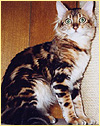 |
|
|
Variants
|
Bengal Variants
 |
Unrecognized Bengal variants include Longhaired Bengals, Blue (blue on apricot), Chocolate, Cinnamon, Albino and Tortoiseshell Bengals. Solid colours (e.g. Black) and Minks (Tonkinese colours) also appear. Because the wild look is lost with the variant colours they are not usually bred.
|
|
Experimental
|
Bengal x Bobcat hybrids
|
Hybrids between Bengals (domestic/F bengalensis) and Bobcats (F rufus). There have been reports of Bengal x Lynx hybrids being bred as pets, but Bengal/Bobcat is more likely.
|
|
Experimental
|
 |
Melanistic Bengals occur in some litters if both parents carry the recessive gene for black coat. Often faint ghost markings of spots and rosettes are visible. They are not bred deliberately within the Bengal breed, but have been used to found the Pantherette breed. See: Pantherette.
|
|
Extinct
|
 |
The Bristol predates the Bengal. Reputed (1980s) to be Domestic x Margay (see picture). The Bristol Cat is very much like the Bengal Cat except that the wild cat used to create this breed was a Margay (Tree Ocelot) instead of the Asian Leopard Cat. One photo showed a cat resembling a big orange Ocicat. Some had a black smoky charcoal colour, others had white/pale underparts and strong rosetting. Had margay/ocelot type rosettes, an ocelot-like voice and small, rounded ears. Once recognized by TICA, but dropped due to lack of numbers and sterility problems. The Bristol died out due to these infertility problems (that's probably why the breed never progressed), but not before remaining cats were absorbed into 2 catteries. Only one cattery was successful at producing offspring, but what resulted were cats with larger bone structure, smaller ears and the greater ability for the spots to rosette. A Bristol female and her Bristol x Bengal offspring were introduced into some Bengal lines to add further wild-type genes and apparently produced the best rosetting.
|
|
Experimental (current?)
|
 |
Semi-longhair Bengal with conformation and colour identical to Bengal. Bred internationally in Europe, UK and US. Derived from only Bengal to Bengal breedings using cats that carry the recessive longhair gene introduced in early corsses of Asian Leopard Cat and domestic cats when founding the Bengal. See also: Pardino
|
|
Experimental
|
Cheetoh
 |
Bengal x Ocicat hybrid. Large, gentle cats with a wild look and inheriting different colours from Ocicat lineage. The aim appears to be to create a very wild-looking domestic cat without further crossings with to wild cats.
|
|
Proposed
|
Cougarin
 |
An attempt to breed a cat resembling a miniature American Cougar; possibly from Bengal x Abyssinian x Domestic Shorthair. The picture shows the result of an accidental mating of a Bengal and a Abyssinian.
|
|
Current
|

|
These include Ocicat x Geoffroy's Cat, Bengal x Geoffroy's Cat. See also: Safari.
|
| Uncertain |
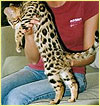 |
The Habari breed is not restricted by purebred genetics, or a preset breed standard, the genetic base is derived from the wide pool of genetics that the breeders have been working with for nearly twenty years. At this point, for various reasons, the breeders have decided not to disclose the ancestry of each individual litter. No pedigree's will be given out. At this time, only a few males have reached maturity. Those that have are 25+ pounds, stand 16 to 18 inches at the shoulder, and are 20 to 22 inches long. The coat pattern we are striving towards is clear, vibrantly colored with large rosettes. At this point, we are not focusing on body type. The Habaris are very social, great with kids and strangers. Most don’t relish being picked up, but will crawl into your lap if you are sitting and will curl up with you in bed.
|
|
Archaic Name, Experimental
|
 |
Polydactyl x Bengal cross, producing a spotted cat in Bengal pattern but with extra toes. Now called Mojave Spotted as the polydactyl cats used are from the Mojave Desert area.
|
|
Current
|
Highland Lynx
 |
Desert Lynx (Bobcat x Abyssinian) x Jungle Curls (F chaus hybrid). Some sources have quoted bengal/F bengalensis as part of the mix.
|
|
Colloquial Name
|
Indian Mau
 |
'Mau''Mau' is a generic name for cat. Two Indian Maus were brought back from the New Delhi in 1982 and used in the Bengal breed.
|
|
Uncertain
|
Jambi
 |
The Jambi, a cross between the native Asian Fishing Cat and the domestic cat, are stoutly built, have cobby bodies, and coats ranging from golden to silver with dark spots. Similar to the other hybrid breeds, they are intelligent, highly active cats that are attracted to water. A newer breed than the Habari, we have not had the opportunity to watch many Jambis mature. We do predict, however, males will be 14 to 22 pounds, and females 9 to 11 pounds. See also Viverral and Machbagral.
|
|
Experimental
|
Jungle Cat Hybrids
 |
Any F chaus x Domestic Cat hybrid of which the Chausie and Euro-Chausie are best known. Other Jungle Cat hybrids include F chaus x black domestic shorthair (black panther-like hybrids) F chaus x Maine Coon (large hybrids), F chaus x Bengal, F chaus x PixieBob.
|
|
Experimental
|
Jungle Curl
 |
Jungle Cat (F chaus) x American Curl (Hemingway Curl) x outcrosses to domestic shorthairs, Serengetis, Jungle cat hybrids, pure Jungle Cats, Bengals, Egyptian Mau, and Abyssinians. Emphasis is on type, not on wild blood percentage. No further crosses with American Curls or any form of bobtail or polydactyl. Has a tendency to have short tail, but this is being bred out as it may be inherited from domestic cats not Jungle Cats. Colours are ebony, blue, sorrel, fawn, chocolate, lilac (including silvers, sepias, snows). Patterns are tawny (ticked with faint barring on tail, legs, chest and face) and leopard (spotted, preferably rosetted, with barring on legs and tail). Sepia, mink and snow varieties have faint leopard spots to appear.
|
|
Experimental
|
Kanaani (Canaan Cat)

|
(Germany) Based on, and bred to resemble, the spotted wildcat subspecies Felis lybica gordonii, but with domestic temperament. Available photos suggest spotted Oriental or Ocicat in seal-spotted tabby, chocolate-spotted tabby and cinnamon-spotted tabby. Classic tabby is permitted, silver colors are disqualified. Large slender cat with long, muscular body, longer hind legs produce slightly raised rump. Long thin tail, tapering towards the tip. Neck is long and slim. Head must not be narrow triangle; has softly rounded forehead and top of skull is flat, prominent straight nose without stop. Distinct chin and slightly flattened snout. Large, open almond shaped eyes with slight slant; eyes green to yellowish-green. Ears are large, open, tapering and wide-set with slight brushes on ear-tips. Fur short, close-lying (but not silky like Siamese), with good ticking of base color, but not obscuring the spots. Spots are horizontally/diagonally aligned (i.e. not broken stripes) with barring on legs, ringed tail and necklaces. Belly is light beige and spotted; chin and throat are light beige/white. Until 2005, Kanaani may be outcrossed to spotted Bengals and spotted Oriental Shorthair, accounting for the slightly oriental appearance.
|
| Uncertain |
Legend Leopards are a unique hybrid cat engineered to produce muscular, large-bodied, heavy boned cats with exotic spots and marbling. They’ve got super sweet personalities and will mature up to twenty pounds. |
|
|
Archaic Name
|
Leopardette
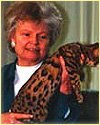 |
At first the Bengal was christened the Leopardette, but Bengal is the name that we know the cat by today. The name was probably derived from the Asian Leopard Cat's scientific name, Prionailurus Bengalensis. See Bengal.
|
| Experimental | Leopold |
There is apparently a breeder (or two) crossbreeding Bengals with Siberian Cats to create something they are calling a "Leopold". Through misleading photos on their website they allude to the breed resembling snow leopards when in fact they do not. There is no reason to crossbreed to create long-haired Bengals as they already exist as a breed called Cashmere Bengals.
|
| Experimental |
 |
Experimental hybrid breed (America/Canada) using the Fishing cat (F viverrina) (see pic) and a spotted melanistic domestic cat (black cat showing shadowy spotted pattern). The aim is to create an exotic-looking cat combining domestic temperament with the appearance of a small black panther with shadowy spotting. Currently in early stages because of low fertility of F1 hybrids. Early hybrids resemble the Fishing Cat and are large, very rounded and have thick, dense fur. Silvery-background to charcoal-blackish coloring with black spotting and markings similar to wild parent. Hybrids are claimed to be very friendly, use the litter tray like a domestic cat but have voracious appetites. They are intelligent, active and have an attraction to water. Also called Bagral. See also Viverral.
|
|
Crossbred
|
Maugal
 |
A cross between Egyptian Mau and Bengal. The Egyptian Mau has been used as the domestic cross in many Bengal breeding programs meaning that many Bengals have a significant proportion of Mau blood. It is thus likely that some pet quality Bengals will actually resemble bronze Egyptian Maus. This practice is no longer condoned by most parts of the Bengal breeding community. In fact it's divided. For instance, Dr. Gregory Kent, is a rogue breeder that firmly believes in utilizing Mau's for breeding. He believes this helps make a Bengal "pure". He's pretty much isolated in this practice, but is he wrong? Who really can say? He's a bit aloof, but you can learn a lot from him. His cattery is Lotsa Spots Cattery and his web site has since disappeared from the web. Under the photo you can still find the webarchive from this website long gone.
|
|
Experimental
|
 |
Polydactyl x Bengal cross, producing a spotted cat in Bengal pattern but with extra toes. Formerly called Hemingway Spotted as polydactyl cats are often known in the USA as Hemingway cats. Now called Mojave Spotted as the polydactyl cats used are from the Mojave Desert area.
|
|
Local Variety
|
Nepali
|
Observed in Nepal: One type is similar to a Bengal, big with elegant elongated legs and pointed faces. colors range from sandy brown to gray always with spots and stripes. The other type resembles the Egyptian Mau with silvery (often almost lavender) coloring with small spots or light stripes. Eye colors are either light green or yellow.
|
|
Experimental (current?)
|
 |
Depending on reference: Black Bengal x Maine Coon or Amur Leopard Cat x Black PixieBob. Black Bengals sometimes occur; these were crossed to a black Maine Coon (for the muscular build). Back crossings to Black Bengals will eliminate the longhair trait. Longhair is recessive and will never be eliminated from the breed. The goal is a domestic cat resembling the Black Panther, with short, dense black coat. Another source cites Amur Leopard Cat (as used for Bengals) x black full-tailed PixieBob to create a cat resembling a Black Panther. See also: Black Bengal.
|
|
Experimental
|
Panthurette
|
This breed officially does not belong in this page because there are no Bengal parents involved. But due to the big resemblance with the breed name Pantherette, I will mention it. In 2001 a man in Texas took beach strays, selecting and breeding them for rounded ears and panther-like looks. He died and his family (not cat-lovers) disposed of the cats, splitting up the breeding stock. The cats are different to the Bengal-based Pantherette. "Panthurette" is an unofficial name used for convenience. Only one stud cat (Panthur) remained at the time of writing (Sept 2001) and was in danger of being neutered due to lack of interest.
|
|
Experimental (current?)
|
 |
A semi-longhair form of Bengal cat. Conformation identical to Bengal. Occurs in all Bengal colours; the colour blue is also recognised (European Group Cat Association). Also known as Cashmere.
|
|
Experimental
|
Punjabi (Punjabi Desert Cat)
 |
Shorthair. Bred in Belgium, the Punjabi is a hybrid of Indian Desert Cat (F lybica supspecies) and Bengals and resemble the desert cat, but with an affectionate temperament. They are large and muscular, but elegant and athletic. Though quiet, they are conversational when spoken to by their owners; they become strongly attached to their owners and do not tolerate loneliness well. Like the desert cat, the coat has small random spots with neither vertical nor horizontal alignment. Marbled patterns are not permitted. Strongly contrasting spots are not essential as the desert cat has low contrast. Ground colour should have 3 bands: silver-white and sandy colour with "scorched" tips. Photos show ivory or pale sandy colours with grey-black and chocolate spots respectively. The head is triangulaar and the ears are relatively large, tail is tapering.
|
|
Experimental
|
Renegade

|
Maine Coon x Bengal plus possibly some other wild cats blood. Aim is to produce a wild-looking cat and the biggest breed of cat. At this early stage, cats have been described as resembling large Abyssinians with tufted ears or pet-quality Bengal-type cats. The picture shows the result of an accidental mating of a Maine Coon and a Bengal.
|
|
Experimental
|
 |
Domestic shorthair x Geoffroy's Cat (some are Bengal x Geoffroy's Cat). Has leopard-spotted or rosetted pattern. Originally developed before the Bengal but interest was limited due to breeding difficulties. After the success of the Bengal, there has been renewed interest in the Safari breed. Compared to other hybrids, first generation crosses have a calm temperament. Safaris closely resemble their Geoffroy's ancestor in type and pattern. They can also be bred in a variety of domestic colours e.g. Geoffroy's x seal point Siamese has black or dark brown spots on a silver to golden ground colour. Geoffroy's x Tortoiseshell Shorthair produce black spotteds, red spotteds and tortie spotteds. Early proposed names were Criollo (meaning "half-bred") and Appaloosa ("spotted"), but these are associated with horses so "Safari" was chosen as suggesting an exotic feline. A few F2 and F3 Safaris do exist, but mostly available for adoption are the F1’s. They also have a tendency to suckle into adulthood, whether it be on an earlobe or a fingertip. They do, however, have a tendency to use water as a litter box. Most owners have taught them to use the toilet or given them a child’s potty training toilet. Some who have tried to keep their Safaris out of the water find their pet using other places to go to the bathroom. So, if you are thinking about a Safari, keep this in mind.
|
|
Alternative or Archaic Name
|
 |
Bengal x Siamese. Large, Siamese type cat with pattern of a snow leopard Bengal and blue eyes. Bengal x Oriental/Siamese crosses produced the Serval-like Serengeti (US). British Savannah apparently renamed in line with the pre-existing American Serengeti and to avoid confusion with the US Savannah hybrid (Serval x domestic) breed. The picture shows the result of an accidental mating between a Snowbengal Queen and a Siamese Sire. So this is an example how this breed in the combination Bengal x Siamese might look.
|
|
Current
|
 |
Domestic x Serval. The Savannah is a hybrid cat created by breeding domestic cats, including Bengals, Oriental Shorthairs, Egyptian Maus and others with Servals (spotted wild cats native to African savannah, hence the name) and aims to replicate the tall, lean Serval. A long-legged, large Oriental with long neck, large rounded ears and Serval-like face. color tawny, gold, orange, silver, black or black smoke with large dark spots and other bold markings, Cheetah-like black markings around eyes. Currently the largest hybrid cat available. Snow Savannahs are derived from Siamese or Snow Bengal crosses and aim to replicate the rare white Serval. Black Savannahs aim to resemble the melanistic Serval. Longhair Savannah variants can occur due to recessive genes. What everybody should know about breeding the Savannah: fertility (or lack thereof) (© messybeast pdf) and Domestic x Serval hybrids (© messybeast pdf).
|
|
Experimental
|
 |
Bengal x Oriental Shorthair crosses (other reports claim Jungle Cat x Bengal but no further information on this hybrid). Large, strong, svelte, long-legged, spotted cat with very upright posture, giving impression of African serval. Very large, upright ears placed on top of the head. Allowable colours as for Bengal: Leopard Spotted, Snow Leopard, plus melanistic (Black Panther). Background colour either clear yellow or cold grey with high contrast spotted pattern. Black or dark brown spots on a clear or unticked tan to yellow body; or black spots on a cold grey body. Spotting should be random; short horizontal bars on the shoulder; tail ringed with black. Underbelly, chin and front of muzzle pale or white. Ghost markings often visible on solid black Serengetis. Modified wedge-shaped head, with broad nose; head is small relative to body size. Thick, blunt-tipped tail. Via the Bengal, the Serengeti contains genes from the Asian Leopard Cat and multiple domestic breeds. Serengetis have been developed simultaneously in USA and UK. American cats have larger ears than the UK breeds due to larger ears found in American Orientals. See also Savannah (UK).
|
|
Current
|
Toyger
 |
Bred from Bengals and domestics to resemble tiger (Toy Tiger) in shape/pattern. Prominent muzzle, large nose leather, wide chin. Muscular, rounded facial contours. Ears small, rounded, furry inside and out; temples/jowls well-furred/ruffed. Eyes slightly slanting, almond shaped, wide set. Long, muscular body, fairly deep, robust-looking, broad-chested, rounded contours. High shoulders and hips. Long tail set and carried low, blunt, rounded, black tip. The heavily-boned fore- and hind legs are the same length; fore-paws proportionally large, black paw pads black. Fur short and plush with glitter (sheen). Stripes black to brown colour extends right to the roots. Markings intense on a rich rufoused background ("pumpkin" colour), background does not darken towards the spine. White background areas are belly, underside of base of tail, insides of legs and chest; these can extend onto the lower sides, backs of legs and sides of chest. Modified mackerel tabby pattern. No dorsal stripe. Distinct, high contrast between markings and background. Vertical body stripes, bands around the neck, legs and tail. Bold, braided (candle-flame), non-uniform stripes preferred, rosetted stripes acceptable. Various stripe forms: narrow striping/narrow spacing; narrow striping/wide spacing; wide striping/wide spacing; wide striping/narrow spacing. Belly and inside of legs must also be marked. Facial stripes and markings circularly aligned around face; forehead butterfly markings and encircling temple and jowl markings. No domestic-type radiating stripes. White facial areas are throat, chin, outer parts of jowls/cheeks, lower part of whisker pads, areas around and over eyes extending onto temples and forehead. Pale/white patches on backs of ears. Eyes black rimmed with white "spectacles", mouth black rimmed. Also known known as Californian Toyger.
|
| Local Variety |
Ussuri
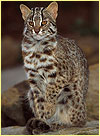 |
Natural hybrids x small wild cats known as "Amur Forest Cats" and "Amur Leopard Cats" (see pic). Asian Leopard cat subspecies, the same species used in the Bengal breed. The Ussuri is a rare natural breed of cat that originates from the region of the Amur river, Russia. Semi-wild Ussuris then hybridised naturally with Siberians and European/Domestic Shorthairs. The breed is rare even in its native Russia. A translated breed standard for this and other native breeds was published in the mid 1990s, but nothing has been heard since that time and its breed status is unclear. The Ussuri's numbers are dwindling due to interbreeding with local domestic cats and, without a breeding programme to preserve the strain, it will disappear. The ears often have "lynx" brushes. The body is muscular, but not massive. The neck is firm but not long. The legs are medium length, muscular and in proportion with firm, rounded paws. The tail has a rounded tip (like the European Wildcat). The color and modified tabby pattern is a distinctive feature of the breed. It has vertical solid or merged spots on the body with lines on the forehead and two or three bronzed lines on cheeks. There should be one or more solid or broken necklaces of bronzed tone on neck and chest. Distinct lines are required on the legs with the upper part being of bronzed color and the lower part of ground color. The tail must be ringed and have a dark tip of ground color. There is a dark dorsal stripe. The flank pattern consists of stripes, rings or spots on golden-brown or goldish-fawn background and bronzed buttons on the paler belly.
|
|
Experimental
|
 |
F viverrina (Fishing cat) x early generation Bengals. First hybrids were in 1995, became genetically stable breed in 2001. Resembles the Fishing Cat, but with domestic temperament. Large, very muscular and solid. Wide nose, prominent whisker pads, large round eyes in a smallish head. Slight convex profile. Short rounded ears with wide base. Thick, low-set, medium-length tail. Short, plush coat. Randomly spotted pattern, black, brown or tan spots. White spectacles. See also: Machbagral.
|
|
Cattery Ifness maakt haar content zelf, of gebruikt een bronvermelding met toestemming. Neem je content over, ook al herschrijf je het, een bronvermelding is wel zo netjes! Wie geen bronvermelding vermeldt, schendt het auteursrecht en is strafbaar. Te gebruiken link:
<a href="http://www.ifness.com/bengaal">© Cattery Ifness</a>
|
